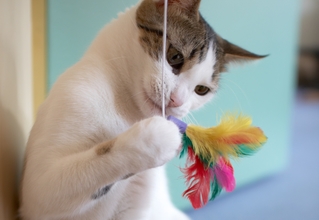Creating A Fun Indoor Environment For Cats

You only need to watch a kitten to realize that cats love to play. For kittens, play is a natural, fun way for them to hone their innate hunting skills. Yet, as indoor kittens become cats they seem to play less and are less engaged in their environment compared to outdoor cats. This is due to the lack of an enriched, interactive environment. Unlike the outdoors, indoor environments tend to be static and uninteresting. These under-enriched environments can lead to psychological stress, leading to inter-cat or owner aggression, urine marking and house soiling behaviors, abnormal feeding behaviors, and psychogenic alopecia (excessive grooming leading to bald patches).
What has been termed "sickness behaviors" can also occur. These include vomiting and diarrhea, decreased interest in eating, grooming or interacting, lethargy and prolonged sleep times. The same physiological and behavioral responses brought on by infection can also be caused by undesirable and stressful changes in the environment. This psychological stress can stimulate the immune system to release chemical substances called cytokines that trigger inflammation in the body. A painful urinary condition called Idiopathic Interstitial Cystitis is a good example of this.
This doesn’t mean we let indoor cats out, into the natural world. This poses great risk to their health and safety, especially for cats with no outdoor "street smarts". Instead, think of your cat’s environment as a "mini zoo" and create a stress-free, enriched environment. Here are some suggestions to consider. Feel free to be creative, your cat will thank you for it and be more emotionally and physically healthy.
Provide safe resting and hiding environments. Hiding is a natural coping behavior for cats. Providing a tall vertical space, such as a cat tree, or a horizontal space, such as a cardboard box, right side up or upside down with a cut out opening works well. This should be placed in your cats primary or core area so she can remove herself from stressful situations.
Provide a place to scratch. Scratching is a natural behavior for cats. It is one of the ways they scent mark and it helps to remove the outer cuticle on the toenails. Some cats have strong substrate preferences, so you may have to experiment a little on coverings for your scratching post. Consider a log, split in half, with a thick bark. Maple logs are a good choice. Mount one piece vertically on a board and leave the other half horizontal on the floor so your cat can have a choice of vertical or horizontal scratching positions.
Appeal to the hunter in your cat. Toys, toys, toys. Cats like to hunt and their play behavior is hunting behavior. A cat’s favorite toy in the wild is a captive animal. To this end some of your cat’s toys should squeak and make noise to appeal to their auditory senses. Keep a wide variety of toys in stock. Cats can habituate to toys after three short sessions, so rotate through three different toys per cat per day. Changing the color of the toys can also help. Small, mobile toys with complex services tend to be more engaging. Many cats benefit from structured play sessions with their owners as a way to establish and maintain their bond. Predatory play behavior can also be encouraged by taking part of the daily food ration and hiding it in multiple places: under small rug or furniture or behind plants. Food can also be hidden in toys such as the IQ Treat Ball (www.ourpets.com) or a Kitty Kong (www.kongcompany.com). Their need to chew can be satisfied by using chicken, turkey or beef jerky treats or cat safe grass. Compressed, American-made rawhide pencils are a good choice for some cats because large, compressed rawhide pieces fall apart if swallowed.
Examples of inexpensive toys include:
- Crumpled paper or aluminum foil
- Feathers or toys on a wand
- Egg cartons with treats inside
- Plastic milk carton rings
- Catnip mice or balls
- Mouse like toys that move or make noise
- Ping pong ball in a bathtub
- Empty toilet paper roll
- Empty paper towel roll waved under a sheet
- Laser pointer
As a side note, some cats can be overly reactive and aggressive after chasing laser pointers, so play sessions should end by pointing the laser dot at a "kill" toy.
Safe and secure resources. Cats can be intense predators in the wild, but they can also be potential prey. They are most vulnerable in the wild while eating or eliminating so these behaviors are usually done in more secluded locations. To this end, food, water and litter boxes should be kept in safe, quiet locations to reduce fearful responses. In the litter box, cats have a greater tactile preference for sand-like clumping litter over traditional clay litter. Think about the difference between walking on a sandy beach versus walking on gravel. Ideally, there should be one litter box per cat plus one.
Olfactory environment. Olfactory signals are important for inter-cat communication and exploration. Many cats like to scent mark their environment by rubbing their whisker pads on corners. Facial marking toys can be attached to corners to direct this behavior. Consider stimulating your olfactory senses with cut grass, catnip or sachets containing cinnamon or cardamom.
Finally, remember that consistency in interactions and predictable daily routines help your cat feel comfortable and safe in his or her environment. Simple rituals such as giving her a treat when leaving the house and petting her when you return help provide a sense of security. Play should be consistent and fun for all involved and never be forced.
